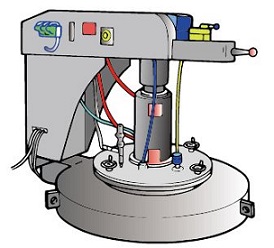Carburizing of gears - Gear Nomenclature
Carburizing and quenching is a type of heat treatment in which carbon is impregnated (carburized) into the surface of a low-carbon alloy steel (steel with low carbon content), such as chrome-molybdenum alloy steel, to bring it to a high-carbon state, followed by quenching and tempering at a low temperature to harden the surface only. Currently, gas carburizing and quenching, in which carburizing is carried out in a gas environment, is the most common method.
Carburizing and quenching improves the wear resistance of the surface area, which is hardened by carbon soaking, while the inside (core), which is not carburized and remains low-carbon, remains soft and tough.
Carburization can be prevented by applying an anti-carburization agent to parts of the surface (anti-carburization treatment), which prevents an increase in hardness in these areas.
If gears are carburized and hardened, deformation and distortion will reduce their accuracy, so grinding is required afterwards to increase accuracy.
The rough guidelines for surface hardness and hardened layer depth are as follows (reference values).
Hardness after hardening : 55 - 63HRC
Effective hardened layer depth : 0.3 - 1.2 mm



